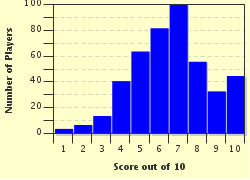Quiz Answer Key and Fun Facts
1. The Battle of Britain took place during the summer and autumn of 1940, as a prelude to the planned invasion of Great Britain by the forces of Nazi Germany. The Germans needed to gain air superiority over British skies before launching "Operation Sea Lion", the German code name for the invasion.
The aircraft probably most associated with the battle is the Supermarine Spitfire. This is with good reason, for the Spitfire was and still is glamorous and pleasing to the eye. However, another British fighter accounted for 60% of Royal Air Force victories in the battle. What was it known as?
2. The term "Battle of Britain" was coined by British Prime Minister Winston Churchill. In a speech to the House of Commons on 18 June 1940, following the fall of France, he said "the Battle of France is over. I expect the Battle of Britain is about to begin".
This was to be an incredibly important conflict. If the RAF failed, there would be no D-Day and the world today would be a very different place.
Whilst we generally think about the battle being fought between the Luftwaffe and the RAF, another nation sent its fighters against Britain. What was its airforce known as?
3. Which German light bomber was known as the "Fliegender Bleistift"?
4. The British Boulton Paul Defiant may be one of the least remembered fighters deployed against the Luftwaffe during the Battle of Britain, being over-shadowed in history by the more famous Hurricane and Spitfire. However, it possessed a unique feature for a fighter of the day. What was it?
5. The most numerous German bomber used by the Luftwaffe during the Battle of Britain was constructed by Heinkel and was known for its distinctive nose. What was it?
6. The Messerschmitt Bf 109 could out perform the British Spitfire in a high-power dive.
7. British civilians on the ground soon became able to recognise the sound of incoming Luftwaffe bomber formations because of their distinctive engine note. What was responsible for the difference in sound when compared to RAF bomber aircraft?
8. Attacking German aircraft were typically based in France and therefore had to cross the English Channel in order to engage with the defending RAF, bomb airfields and to sink British ships.
Not wanting to abandon those pilots and crew who were unfortunate to end up in the channel as a result of being shot down or forced to ditch, the Luftwaffe established an air-sea rescue service using what seaplane aircraft?
9. The Spitfire and the Hurricane were powered by Rolls Royce engines. The Me109 was powered by a Daimler-Benz. The Junkers 88 was also powered by a familiar manufacturer, still in existence. Which was it?
10. It is still possible with the aid of a metal detector to find evidence of this great battle in the form of spent .303 cartridges and cannon shell. However a much more important discovery was recently made off the coast of southern England. An almost complete German bomber was found buried in coastal sands.
Source: Author
keanet
This quiz was reviewed by FunTrivia editor
bloomsby before going online.
Any errors found in FunTrivia content are routinely corrected through our feedback system.

